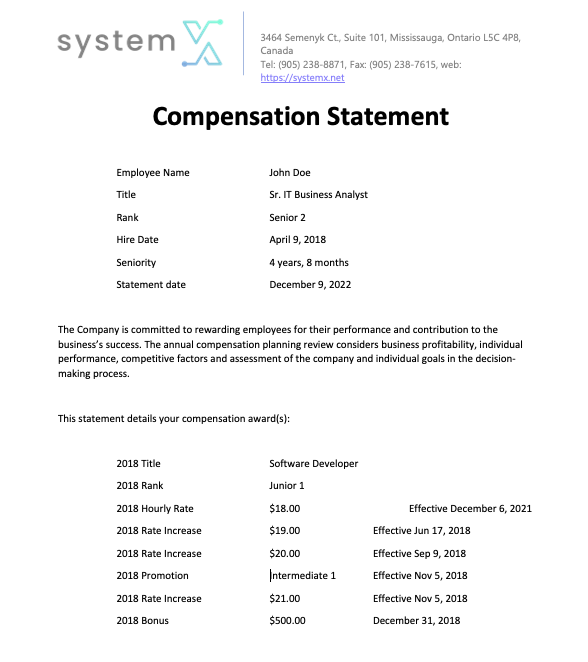Introduction
In today’s rapidly evolving workplace, transparency has become more than a buzzword; it’s a cornerstone of effective employee relations. One significant yet often overlooked tool in this endeavor is the compensation statement. It’s more than just a breakdown of salaries; it’s a communication channel that fosters trust and clarity between employers and employees – an essential part of company culture.
The Concept of Compensation Statements
At its core, a compensation statement is a detailed document provided by employers to their employees, outlining the full scope of their compensation package. This includes not only the base salary but also bonuses, benefits, stock options, and any additional perks. Historically, compensation was a hush-hush topic. However, the modern workplace, fuelled by a push towards transparency and fairness, has seen a shift towards open dialogue about remuneration.

Benefits of Providing Compensation Statements
- Transparency and Trust: When a company openly shares compensation details, it sets a tone of trust. Employees feel more secure knowing exactly what their compensation entails and why.
- Employee Retention: Understanding the full value of their compensation can significantly impact an employee’s satisfaction and loyalty. This clarity often results in lower turnover rates.
- Recruitment Advantage: In the competitive job market, transparency about compensation can give a company a significant edge in attracting top talent.
- Legal Compliance and Clarity: In some regions, there are legal requirements for compensation transparency. Providing detailed compensation statements ensures compliance and avoids potential legal pitfalls.
Challenges and Considerations
Despite its benefits, the implementation of compensation statements can be challenging. Concerns about privacy, the complexity of information, and potential misunderstandings are valid. However, these can be mitigated through clear communication, proper data management, and employee education.
How to Effectively Create and Distribute Compensation Statements
Creating effective compensation statements requires a clear understanding of what employees value and seek clarity on. Here are some steps:
- Detail Every Component: Clearly outline every part of the compensation package.
- Use Understandable Language: Avoid jargon to ensure clarity.
- Leverage Technology: SystemX’s HR Module can help access all the information needed to make compensation statements quickly
Going Above and Beyond in Compensation Transparency
While basic compensation statements offer significant benefits, companies can truly stand out by adding extra layers of information and appreciation. This can take transparency and employee engagement to the next level.
- Historical Compensation Data: Including a retrospective look at an employee’s earnings over previous years is a powerful tool. It provides employees with a clear picture of their financial growth within the company. This data can be particularly motivating, as it tangibly shows the employee’s progression and the company’s investment in their development. For instance, showing a 5-year history where an employee sees their salary growth can be incredibly affirming and motivating.
- Personalized Appreciation: Adding a personalized paragraph in the compensation statement that thanks the employee for their contributions can significantly boost morale. This acknowledgment shows that the company doesn’t just see its employees as numbers, but values them as integral parts of the organization. A simple statement like, “Thank you, John, for your exceptional contributions this year, particularly in the XYZ project, which greatly enhanced our client engagement,” can make a world of difference.
- Future Growth and Promotion Opportunities: Providing insights into potential future career paths and promotion opportunities within the statement can be highly motivating. This not only helps employees understand their potential trajectory within the company but also aligns their personal goals with the organization’s growth. For example, outlining a potential path from a junior role to a managerial position, along with the associated compensation changes, gives employees a clear vision of what they can aspire to achieve.
Incorporating these elements not only enhances the transparency of compensation statements but also serves as a tool for employee recognition and motivation. By showing employees where they’ve been, where they are, and where they can go, companies can foster a deeper sense of loyalty and engagement.
The Future of Workplace Transparency
The trend towards transparency in compensation is not just a passing phase. It’s a reflection of the evolving work culture that values fairness and open communication. Companies that adopt this practice not only stay ahead in the talent game but also build a more committed and satisfied workforce.
Conclusion
Compensation statements are a vital tool in the modern employer’s toolkit. They go beyond mere compliance; they build a culture of trust and respect. As businesses continue to navigate the changing landscape of employee relations, embracing transparency in compensation can be a significant step towards a more engaged and loyal workforce.
How does your organization handle compensation transparency?

